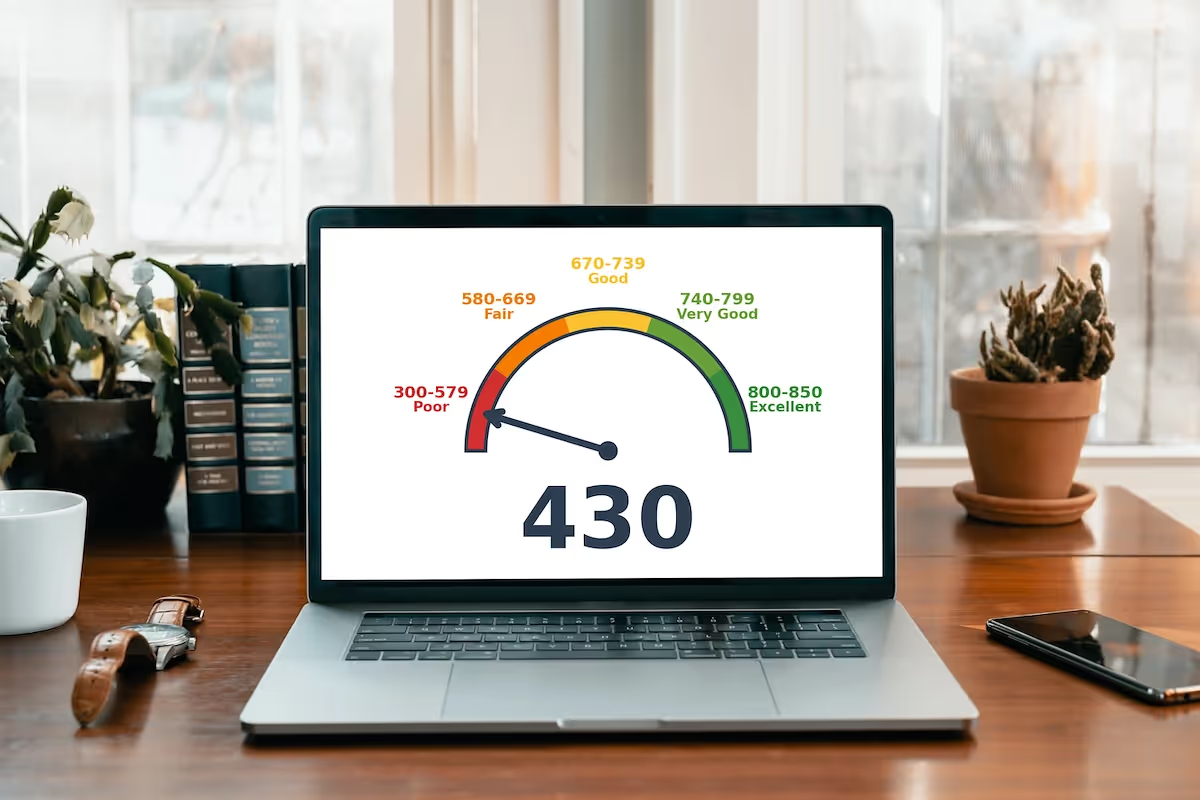
Kudos has partnered with CardRatings and Red Ventures for our coverage of credit card products. Kudos, CardRatings, and Red Ventures may receive a commission from card issuers. Kudos may receive commission from card issuers. Some of the card offers that appear on Kudos are from advertisers and may impact how and where card products appear on the site. Kudos tries to include as many card companies and offers as we are aware of, including offers from issuers that don't pay us, but we may not cover all card companies or all available card offers. You don't have to use our links, but we're grateful when you do!
430 Credit score: What You Need to Know in 2025
July 1, 2025


TL;DR
A 430 credit score offers a significant opportunity for growth and is a starting point for building a stronger financial profile. This score falls into the “Poor” FICO score category, which provides a clear roadmap for improvement.
What Does a 430 Credit Score Mean?
A credit score of 430 is considered "poor" on the standard FICO Score range of 300 to 850. To lenders, this score indicates a very high-risk borrower, which can create significant financial obstacles. You may find it difficult to be approved for new credit cards or loans, and even renting an apartment could be challenging. If you are approved for credit, it will likely come with very high interest rates and unfavorable terms.
While a 430 score certainly presents challenges, it is not a permanent state. Think of it as a baseline from which you can begin to build a stronger financial foundation. Understanding what this score means is the crucial first step toward improving your credit standing and working toward a more secure financial future.
Who Has a 430 Credit Score?
While age is not a direct factor in credit score calculations, scores tend to increase over time as people build their credit history. According to 2023 data, the average credit scores by generation are:
- Generation Z (ages 18-26): 680
- Millennials (ages 27-42): 690
- Generation X (ages 43-58): 709
- Baby Boomers (ages 59-77): 745
- Silent Generation (ages 78+): 760
Credit Cards With a 430 Credit Score
A credit score of 430 falls into the "very poor" range, which can make qualifying for a traditional credit card a significant challenge. Most major issuers view this score as a high-risk indicator, meaning your application is likely to be rejected for standard unsecured cards. Consequently, your options will probably be limited to secured credit cards that require a cash deposit or specific subprime cards that come with steep fees and high interest rates.
The fintech company Kudos offers AI-powered tools to help you navigate the credit card landscape, matching your financial situation to its database of nearly 3,000 cards. These tools provide personalized recommendations and credit score insights, helping you make an informed decision to find a suitable card and begin rebuilding your credit.
Auto Loans and a 430 Credit Score
A 430 credit score places you in the deep subprime category, meaning that while you may still get approved for an auto loan, the terms will be unfavorable. Lenders view this score as high-risk, resulting in significantly higher interest rates according to a 2025 market report.
- Super-prime (781-850): 5.25% for new cars and 7.13% for used cars
- Prime (661-780): 6.87% for new cars and 9.36% for used cars
- Non-prime (601-660): 9.83% for new cars and 13.92% for used cars
- Subprime (501-600): 13.18% for new cars and 18.86% for used cars
- Deep subprime (300-500): 15.77% for new cars and 21.55% for used cars
Mortgages at a 430 Credit Score
A 430 credit score falls below the minimum threshold for nearly all mainstream mortgage programs. For instance, government-backed FHA loans, known for their flexibility, have minimum score requirements starting at 500 with a 10% down payment. As such, securing a traditional home loan with a 430 score is highly unlikely, as it is well below the range most lenders will consider.
If you were to find a rare specialty or subprime lender, your credit score would lead to unfavorable terms. Expect to face significantly higher interest rates, larger fees, and a substantial down payment requirement. Lenders may also cap the loan amount, limiting your options for homes you can afford.
What's in a Credit Score?
Figuring out what goes into your credit score can feel like trying to solve a complex puzzle, but it generally boils down to a handful of key elements. The most common factors include:
- Your history of making payments on time is the most significant factor.
- How much of your available credit you're currently using, known as your credit utilization ratio, plays a major role.
- The age of your credit accounts, including the average age and the age of your oldest account, is also considered.
- Lenders like to see that you can responsibly manage different types of credit, such as credit cards and loans.
- Opening several new credit accounts in a short period can be seen as a risk and may temporarily lower your score.
How to Improve Your 430 Credit Score
Your credit score plays a crucial role in your financial life, but a low number isn't a permanent setback. With consistent, positive financial behavior, it is entirely possible to improve your creditworthiness and build a healthier profile over time.
- Set up automatic bill payments. Since payment history is the most significant factor in your score, this ensures you never miss a due date. Building a consistent record of on-time payments is the most critical step to recovering from a very poor score.
- Apply for a secured credit card. A 430 score makes it difficult to get approved for traditional cards, but a secured card is an excellent tool for rebuilding credit. Your responsible use and on-time payments are reported to the credit bureaus, helping you establish a positive history.
- Reduce your credit utilization ratio. This ratio of your balance to your credit limit heavily influences your score, and keeping it below 30% is key. Paying down existing balances shows lenders you can manage debt responsibly and can give your score a significant lift.
- Monitor your credit reports. Regularly checking your reports from all three bureaus helps you identify and dispute inaccuracies that could be unfairly hurting your score. This also allows you to track your progress and stay motivated as you work to improve your credit.
The Kudos browser extension can help you manage your cards and monitor your score as you work to improve your financial health.
Unlock your extra benefits when you become a Kudos member

Turn your online shopping into even more rewards

Join over 400,000 members simplifying their finances

Editorial Disclosure: Opinions expressed here are those of Kudos alone, not those of any bank, credit card issuer, hotel, airline, or other entity. This content has not been reviewed, approved or otherwise endorsed by any of the entities included within the post.



































.webp)



.webp)

.webp)


